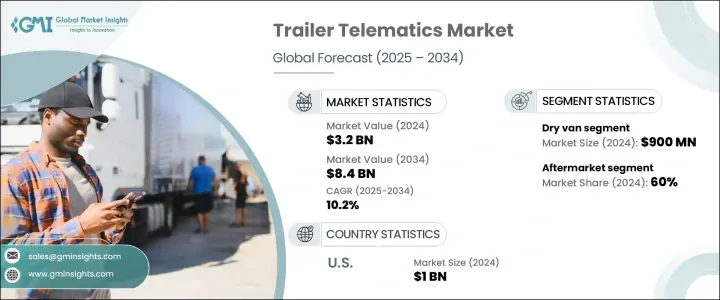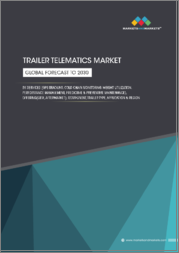
|
시장보고서
상품코드
1708246
트레일러 텔레매틱스 시장 기회, 성장 촉진요인, 산업 동향 분석, 예측(2025-2034년)Trailer Telematics Market Opportunity, Growth Drivers, Industry Trend Analysis, and Forecast 2025 - 2034 |
||||||
세계의 트레일러 텔레매틱스 시장 규모는 2024년에 32억 달러에 달하며, 2025-2034년의 CAGR은 10.2%로 예측되며, 대폭적인 성장이 전망되고 있습니다.
시장 확대의 원동력은 규제 요건 증가, 업무 효율화의 필요성, 사물인터넷(IoT) 기술의 확산입니다. 미국의 전자기록장비(ELD) 의무화, 유럽의 타코그래프 법 시행 등 세계 각국 정부가 엄격한 규제 준수 조치를 시행하고 있으며, 차량 운영자는 첨단 텔레매틱스 솔루션을 통합해야 합니다. 이러한 기술은 실시간으로 트레일러를 추적하고, 화물의 상태를 모니터링하고, 연비를 개선하고, 규정 준수를 보장하는 동시에 차량 성능을 최적화합니다.

운송 및 물류 부문이 계속 진화하고 있는 가운데, 차량 운영자들은 경쟁력을 확보하기 위해 첨단 텔레매틱스를 빠르게 도입하고 있습니다. 데이터베이스 인사이트에 대한 수요가 증가함에 따라 트레일러 관리 전략을 재구성하고 첨단 텔레매틱스 시스템에 대한 투자를 늘리고 있습니다. 향상된 센서 통합, 장수명 배터리 기술, 모듈형 텔레매틱스 솔루션과 같은 혁신은 업계 표준을 재정의하고 있습니다. 이러한 발전은 예지보전을 통해 다운타임을 최소화하고, 전체 차량의 효율성을 높이며, 운영 비용을 절감하는 데 도움이 되고 있습니다. 업계에서는 실시간 데이터 분석과 차량 관리 시스템과의 원활한 통합을 가능하게 하는 클라우드 기반 텔레매틱스 플랫폼에 대한 수요도 급증하고 있습니다. 화물 안전에 대한 우려가 높아지면서 최적화된 물류에 대한 필요성과 함께 시장 확대가 가속화되고 있으며, E-Commerce 및 라스트마일 배송 서비스가 급증하면서 트레일러 텔레매틱스는 적시 배송, 고객 만족도 향상, 공급망 운영의 비효율성 감소에 필수적인 요소로 작용하고 있습니다. 공급망 운영의 비효율성을 줄이는 데 필수적인 역할을 하고 있습니다.
| 시장 범위 | |
|---|---|
| 시작연도 | 2024년 |
| 예측연도 | 2025-2034년 |
| 시작 금액 | 32억 달러 |
| 예상 금액 | 84억 달러 |
| CAGR | 10.2% |
시장은 드라이밴, 플랫베드, 냉동 트레일러, 스텝데크 트레일러 등 트레일러 유형별로 구분됩니다. 현재 드라이밴 트레일러가 가장 큰 시장 점유율을 차지하고 있으며, 2024년에는 약 9억 달러의 매출을 창출할 것으로 예측됩니다. 다양한 상품 운송에 광범위하게 사용되고 있는 드라이밴은 실시간 추적, 화물 모니터링, 경로 최적화를 제공하는 텔레매틱스 솔루션의 혜택을 누리고 있으며, E-Commerce가 활성화됨에 따라 첨단 텔레매틱스가 탑재된 드라이밴 트레일러에 대한 수요가 증가하고 있습니다. 첨단 텔레매틱스가 탑재된 드라이밴 트레일러에 대한 수요가 증가하고 있으며, 기업은 배송 효율을 높이고 물류 업무를 간소화하는 데 도움을 받고 있습니다.
판매 채널 측면에서 트레일러 텔레매틱스 시장은 애프터마켓 부문과 OEM(주문자 상표 부착) 부문으로 나뉩니다. 애프터마켓 부문이 시장을 독점하고 있으며, 2024년에는 전체 점유율의 60%를 차지합니다. 많은 차량 운영자들은 새로운 유닛에 투자하는 것보다 기존 트레일러에 텔레매틱스 시스템을 장착하는 것을 선호합니다. 이러한 접근 방식을 통해 차량 가시성을 개선하고, 안전성을 높이고, 규정을 준수하는 동시에 운영 비용을 절감할 수 있습니다. 기술이 발전함에 따라 애프터마켓 텔레매틱스 솔루션은 점점 더 정교해지고 있으며, 차량 성능을 최적화하기 위해 향상된 데이터 분석 및 원격 진단 기능을 제공합니다.
미국 트레일러 텔레매틱스 시장은 2024년 10억 달러의 매출을 창출하며 업계 성장에 크게 기여할 것으로 예측됩니다. 이 시장은 운송 및 물류 부문 전반에 걸쳐 텔레매틱스 솔루션이 광범위하게 채택되면서 예측 기간 중 10.5%의 연평균 복합 성장률(CAGR)을 보일 것으로 예측됩니다. 미국에서는 ELD 의무화가 텔레매틱스 도입의 주요 원동력이 되고 있으며, 차량 운영업체들이 첨단 추적 및 모니터링 솔루션에 대한 투자를 촉진하고 있습니다. 물류 업계가 데이터베이스 의사결정을 계속 수용함에 따라 이 지역의 트레일러 텔레매틱스 수요는 크게 증가할 것으로 예상되며, 미국이 세계 시장 리더로서의 입지를 강화할 것으로 전망됩니다.
목차
제1장 조사 방법과 조사 범위
제2장 개요
제3장 업계 인사이트
- 에코시스템 분석
- 공급업체 상황
- 원재료 제조업체
- 부품 제조업체
- 제조업체
- 기술 프로바이더
- 유통 채널 분석
- 최종 용도
- 이익률 분석
- 공급업체 상황
- 기술과 혁신 전망
- 특허 분석
- 규제 상황
- 비용 내역 분석
- 주요 뉴스&구상
- 영향요인
- 촉진요인
- 플릿 최적화와 효율화에 대한 수요 증가
- 물류에서 IoT와 AI의 채택 증가
- 차량 안전성과 컴플라이언스에 관한 엄격한 규제
- E-Commerce와 공급망 디지털화의 확대
- 업계의 잠재적 리스크 & 과제
- 높은 초기 도입 비용
- 데이터 보안과 사이버 보안 우려
- 촉진요인
- 성장 가능성 분석
- Porter의 산업 분석
- PESTEL 분석
제4장 경쟁 구도
- 서론
- 기업 점유율 분석
- 경쟁 포지셔닝 매트릭스
- 전략 전망 매트릭스
제5장 시장 추산·예측 : 트레일러별, 2021-2034년
- 주요 동향
- 드라이 밴
- 냉장 트레일러
- 플랫베드 트레일러
- 스텝 데크 트레일러
제6장 시장 추산·예측 : 커넥티비티별, 2021-2034년
- 주요 동향
- 셀룰러 기반
- 위성통신 기반
제7장 시장 추산·예측 : 컴포넌트별, 2021-2034년
- 주요 동향
- 하드웨어
- 소프트웨어
- 서비스
제8장 시장 추산·예측 : 최종 용도별, 2021-2034년
- 주요 동향
- 운송·물류
- 식품 및 음료
- 건설
- 석유 및 가스
- 기타
제9장 시장 추산·예측 : 판매채널별, 2021-2034년
- 주요 동향
- OEM
- 애프터마켓
제10장 시장 추산·예측 : 지역별, 2021-2034년
- 주요 동향
- 북미
- 미국
- 캐나다
- 유럽
- 독일
- 프랑스
- 영국
- 스페인
- 이탈리아
- 러시아
- 북유럽
- 아시아태평양
- 중국
- 인도
- 일본
- 한국
- 뉴질랜드
- 동남아시아
- 라틴아메리카
- 브라질
- 멕시코
- 아르헨티나
- 중동 및 아프리카
- UAE
- 남아프리카공화국
- 사우디아라비아
제11장 기업 개요
- CalAmp
- Clarience Technologies
- Eroad
- Fleet Complete
- Geotab
- Hyundai Translead
- Krone Trailer
- Omnitracs
- Orbcomm
- Phillips Connect
- Samsara
- Schmitz Cargobull
- Skybitz
- Solera Holdings
- Spireon
- Teletrac Navman
- Trendfire Technologies
- Verizon Connect
- Wabash National
- WABCO
The Global Trailer Telematics Market, valued at USD 3.2 billion in 2024, is set to experience substantial growth, with a projected CAGR of 10.2% from 2025 to 2034. The market expansion is being fueled by increasing regulatory requirements, the need for greater operational efficiency, and the widespread adoption of Internet of Things (IoT) technologies. Governments worldwide are enforcing strict compliance measures, such as the Electronic Logging Device (ELD) mandate in the United States and tachograph laws in Europe, compelling fleet operators to integrate advanced telematics solutions. These technologies provide real-time trailer tracking, monitor cargo conditions, and optimize fleet performance while improving fuel efficiency and ensuring regulatory compliance.

As the transportation and logistics sector continues to evolve, fleet operators are rapidly adopting advanced telematics to gain a competitive edge. The growing demand for data-driven insights is reshaping trailer management strategies, leading to increased investments in cutting-edge telematics systems. Innovations such as enhanced sensor integration, long-lasting battery technology, and modular telematics solutions are redefining industry standards. These advancements help minimize downtime through predictive maintenance, enhance overall fleet efficiency, and reduce operational costs. The industry is also witnessing a surge in demand for cloud-based telematics platforms, which enable real-time data analytics and seamless integration with fleet management systems. Rising concerns over cargo security, coupled with the need for optimized logistics, are further accelerating market expansion. The ongoing surge in e-commerce and last-mile delivery services has made trailer telematics indispensable for ensuring timely deliveries, improving customer satisfaction, and reducing inefficiencies in supply chain operations.
| Market Scope | |
|---|---|
| Start Year | 2024 |
| Forecast Year | 2025-2034 |
| Start Value | $3.2 Billion |
| Forecast Value | $8.4 Billion |
| CAGR | 10.2% |
The market is segmented by trailer type, including dry vans, flatbeds, refrigerated trailers, and step deck trailers. Dry van trailers currently hold the largest market share, generating approximately USD 900 million in revenue in 2024. Widely used for transporting a diverse range of goods, dry vans benefit significantly from telematics solutions, which provide real-time tracking, cargo monitoring, and route optimization. As e-commerce continues to thrive, the demand for dry van trailers equipped with advanced telematics is growing, helping companies enhance delivery efficiency and streamline logistics operations.
Regarding sales channels, the trailer telematics market is divided into the aftermarket and original equipment manufacturer (OEM) segments. The aftermarket sector dominates the market, accounting for 60% of the total share in 2024. Many fleet operators prefer retrofitting their existing trailers with telematics systems rather than investing in new units. This approach allows them to improve fleet visibility, enhance safety, and comply with regulatory mandates while keeping operational costs in check. As technology evolves, aftermarket telematics solutions are becoming increasingly sophisticated, offering enhanced data analytics and remote diagnostics to optimize fleet performance.
The U.S. Trailer Telematics Market is a major contributor to the industry's growth, generating USD 1 billion in revenue in 2024. The market is expected to expand at a CAGR of 10.5% over the forecast period, driven by the widespread adoption of telematics solutions across the transportation and logistics sectors. The ELD mandate has been a key driver of telematics implementation in the U.S., prompting fleet operators to invest in advanced tracking and monitoring solutions. As the logistics industry continues to embrace data-driven decision-making, the demand for trailer telematics in the region is projected to rise significantly, reinforcing the U.S. position as a leader in the global market.
Table of Contents
Chapter 1 Methodology & Scope
- 1.1 Research design
- 1.1.1 Research approach
- 1.1.2 Data collection methods
- 1.2 Base estimates & calculations
- 1.2.1 Base year calculation
- 1.2.2 Key trends for market estimation
- 1.3 Forecast model
- 1.4 Primary research and validation
- 1.4.1 Primary sources
- 1.4.2 Data mining sources
- 1.5 Market scope & definition
Chapter 2 Executive Summary
- 2.1 Industry 3600 synopsis, 2021 - 2034
Chapter 3 Industry Insights
- 3.1 Industry ecosystem analysis
- 3.1.1 Supplier landscape
- 3.1.1.1 Raw material providers
- 3.1.1.2 Component providers
- 3.1.1.3 Manufacturers
- 3.1.1.4 Technology providers
- 3.1.1.5 Distribution channel analysis
- 3.1.1.6 End use
- 3.1.2 Profit margin analysis
- 3.1.1 Supplier landscape
- 3.2 Technology & innovation landscape
- 3.3 Patent analysis
- 3.4 Regulatory landscape
- 3.5 Cost breakdown analysis
- 3.6 Key news & initiatives
- 3.7 Impact forces
- 3.7.1 Growth drivers
- 3.7.1.1 Rising demand for fleet optimization & efficiency
- 3.7.1.2 Increasing adoption of IOT & AI in logistics
- 3.7.1.3 Stringent regulations for fleet safety & compliance
- 3.7.1.4 Expansion of e-commerce & supply chain digitization
- 3.7.2 Industry pitfalls & challenges
- 3.7.2.1 High initial implementation costs
- 3.7.2.2 Data security & cybersecurity concerns
- 3.7.1 Growth drivers
- 3.8 Growth potential analysis
- 3.9 Porter's analysis
- 3.10 PESTEL analysis
Chapter 4 Competitive Landscape, 2024
- 4.1 Introduction
- 4.2 Company market share analysis
- 4.3 Competitive positioning matrix
- 4.4 Strategic outlook matrix
Chapter 5 Market Estimates & Forecast, By Trailer, 2021 - 2034 ($Mn)
- 5.1 Key trends
- 5.2 Dry van
- 5.3 Refrigerated trailer
- 5.4 Flatbed trailer
- 5.5 Step-deck trailer
Chapter 6 Market Estimates & Forecast, By Connectivity, 2021 - 2034 ($Mn)
- 6.1 Key trends
- 6.2 Cellular-based
- 6.3 Satellite-based
Chapter 7 Market Estimates & Forecast, By Component, 2021 - 2034 ($Mn)
- 7.1 Key trends
- 7.2 Hardware
- 7.3 Software
- 7.4 Services
Chapter 8 Market Estimates & Forecast, By End Use 2021 - 2034 ($Mn)
- 8.1 Key trends
- 8.2 Transportation & logistics
- 8.3 Food & beverage
- 8.4 Construction
- 8.5 Oil & gas
- 8.6 Others
Chapter 9 Market Estimates & Forecast, By Sales Channel, 2021 - 2034 ($Mn)
- 9.1 Key trends
- 9.2 OEM
- 9.3 Aftermarket
Chapter 10 Market Estimates & Forecast, By Region, 2021 - 2034 ($Mn)
- 10.1 Key trends
- 10.2 North America
- 10.2.1 U.S.
- 10.2.2 Canada
- 10.3 Europe
- 10.3.1 Germany
- 10.3.2 France
- 10.3.3 UK
- 10.3.4 Spain
- 10.3.5 Italy
- 10.3.6 Russia
- 10.3.7 Nordics
- 10.4 Asia Pacific
- 10.4.1 China
- 10.4.2 India
- 10.4.3 Japan
- 10.4.4 South Korea
- 10.4.5 ANZ
- 10.4.6 Southeast Asia
- 10.5 Latin America
- 10.5.1 Brazil
- 10.5.2 Mexico
- 10.5.3 Argentina
- 10.6 MEA
- 10.6.1 UAE
- 10.6.2 South Africa
- 10.6.3 Saudi Arabia
Chapter 11 Company Profiles
- 11.1 CalAmp
- 11.2 Clarience Technologies
- 11.3 Eroad
- 11.4 Fleet Complete
- 11.5 Geotab
- 11.6 Hyundai Translead
- 11.7 Krone Trailer
- 11.8 Omnitracs
- 11.9 Orbcomm
- 11.10 Phillips Connect
- 11.11 Samsara
- 11.12 Schmitz Cargobull
- 11.13 Skybitz
- 11.14 Solera Holdings
- 11.15 Spireon
- 11.16 Teletrac Navman
- 11.17 Trendfire Technologies
- 11.18 Verizon Connect
- 11.19 Wabash National
- 11.20 WABCO
















